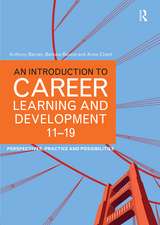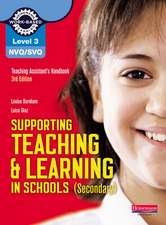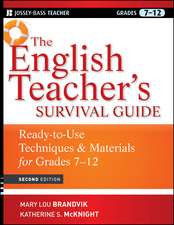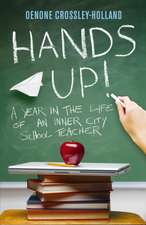Practical Work in Secondary Science: A Minds-On Approach
Autor Dr Ian Abrahamsen Limba Engleză Paperback – 17 noi 2010
| Toate formatele și edițiile | Preț | Express |
|---|---|---|
| Paperback (1) | 304.37 lei 6-8 săpt. | |
| Bloomsbury Publishing – 17 noi 2010 | 304.37 lei 6-8 săpt. | |
| Hardback (1) | 1007.04 lei 6-8 săpt. | |
| Bloomsbury Publishing – 17 noi 2010 | 1007.04 lei 6-8 săpt. |
Preț: 304.37 lei
Preț vechi: 352.99 lei
-14% Nou
Puncte Express: 457
Preț estimativ în valută:
58.24€ • 61.09$ • 48.48£
58.24€ • 61.09$ • 48.48£
Carte tipărită la comandă
Livrare economică 01-15 aprilie
Preluare comenzi: 021 569.72.76
Specificații
ISBN-13: 9781847065049
ISBN-10: 184706504X
Pagini: 160
Dimensiuni: 184 x 239 x 11 mm
Greutate: 0.33 kg
Editura: Bloomsbury Publishing
Colecția Continuum
Locul publicării:London, United Kingdom
ISBN-10: 184706504X
Pagini: 160
Dimensiuni: 184 x 239 x 11 mm
Greutate: 0.33 kg
Editura: Bloomsbury Publishing
Colecția Continuum
Locul publicării:London, United Kingdom
Caracteristici
User-friendly case studies from teachers and pupils involved in practical work in the science classroom
Notă biografică
Ian Abrahams is Associate Professor of Science Education at the University of Leeds, UK.
Cuprins
Acknowledgements \ Introduction \ 1. The Purpose of Practical Work \ 2. Current Perspectives on the Nature and Purpose of Practical Work in the Affective Domain \ 3. Key Issues for Practical Work \ 4. What Pupils Learn About Objects, Materials and Ideas \ 5. Strategies for Getting Pupils to Think about the Objects, Materials and Ideas \ 6. Conclusion \ References \ Index
Recenzii
'This rigorous yet readable book should be read by every teacher of secondary science. Ian Abrahams provides a compelling analysis of how practical work should be at the heart of school science but too often fails to reach its potential. I wish I had read this book while I was still teaching in schools.' Michael Reiss, Professor of Science Education, Institute of Education, University of London, UK
'Ian Abrahams integrates our knowledge regarding teaching, learning and researching in the school science laboratory. This book will be relevant to science teachers who seek ways to improve their practice in the laboratory, as well as professional development providers and science educators teaching graduate courses in colleges and universities.' Avi Hofstein, Head of the Chemistry Group, Department of Science Teaching, The Weizmann Institute of Science, Israel
'The book is very readable and presents the findings of his thesis and later research in a way that is engaging and interesting. The book is separated into chapters that, if required, can be read as stand-alone pieces of work, but they follow on from one another in a logical manner, drawing the reader through to the key chapter on 'strategies to get pupils to think'. The chapter 'current perspectives on practical work' will strike a chord with most practising teachers and trainee teachers. The conversations between the researcher and the pupils support the research results shown in the tables of data, most notably that practical work is deemed to be an opportunity to do something that is not writing. The chapter on 'key issues' looks at the many pitfalls involved in getting pupils to carry out practical work, from reading worksheets and being sufficiently skilled in setting up the apparatus, to collecting data from the equipment and this also highlights the importance of the teacher knowing the difficulties and passing this information onto the pupils. This type of information is something that all trainee teachers have to consider and I am sure that they will find this a valuable resource. The chapter on 'what pupils learn' draws upon research to show that most pupils remember the unusual events and very little about the science behind them. He stresses the importance of making a bridge between practical work and the theory behind it particularly in the context of the practical lesson. It offers sound advice that is supported by research. This is a good read and a book that has some good advice to offer not only to trainee teachers but also more experienced teachers who wish to develop their practical work further.' Janet Gibbs, Lecturer in Science Education, University of Hull, UK
'Ian Abrahams has written a book about how teachers and pupils perceive science 'practicals' that should be required reading for all science teachers.'
Abrahams makes a valid and powerful case that practical work cannot simply be assumed to be beneficial to students' learning. He highlights that teachers must spend time scaffolding students' attention from real objects and observations in the laboratory to abstract concepts. The assumption that fun and impressive practicals necessarily and automatically lead to effective learning is simplistic but prevalent. The data in this book must cause teachers to reflect and re-evaluate how they use practicals. For that reason this is a valuable and insightful text that will help teachers to make their practical work more effective in changing students' conceptual understanding.
'Ian Abrahams integrates our knowledge regarding teaching, learning and researching in the school science laboratory. This book will be relevant to science teachers who seek ways to improve their practice in the laboratory, as well as professional development providers and science educators teaching graduate courses in colleges and universities.' Avi Hofstein, Head of the Chemistry Group, Department of Science Teaching, The Weizmann Institute of Science, Israel
'The book is very readable and presents the findings of his thesis and later research in a way that is engaging and interesting. The book is separated into chapters that, if required, can be read as stand-alone pieces of work, but they follow on from one another in a logical manner, drawing the reader through to the key chapter on 'strategies to get pupils to think'. The chapter 'current perspectives on practical work' will strike a chord with most practising teachers and trainee teachers. The conversations between the researcher and the pupils support the research results shown in the tables of data, most notably that practical work is deemed to be an opportunity to do something that is not writing. The chapter on 'key issues' looks at the many pitfalls involved in getting pupils to carry out practical work, from reading worksheets and being sufficiently skilled in setting up the apparatus, to collecting data from the equipment and this also highlights the importance of the teacher knowing the difficulties and passing this information onto the pupils. This type of information is something that all trainee teachers have to consider and I am sure that they will find this a valuable resource. The chapter on 'what pupils learn' draws upon research to show that most pupils remember the unusual events and very little about the science behind them. He stresses the importance of making a bridge between practical work and the theory behind it particularly in the context of the practical lesson. It offers sound advice that is supported by research. This is a good read and a book that has some good advice to offer not only to trainee teachers but also more experienced teachers who wish to develop their practical work further.' Janet Gibbs, Lecturer in Science Education, University of Hull, UK
'Ian Abrahams has written a book about how teachers and pupils perceive science 'practicals' that should be required reading for all science teachers.'
Abrahams makes a valid and powerful case that practical work cannot simply be assumed to be beneficial to students' learning. He highlights that teachers must spend time scaffolding students' attention from real objects and observations in the laboratory to abstract concepts. The assumption that fun and impressive practicals necessarily and automatically lead to effective learning is simplistic but prevalent. The data in this book must cause teachers to reflect and re-evaluate how they use practicals. For that reason this is a valuable and insightful text that will help teachers to make their practical work more effective in changing students' conceptual understanding.














